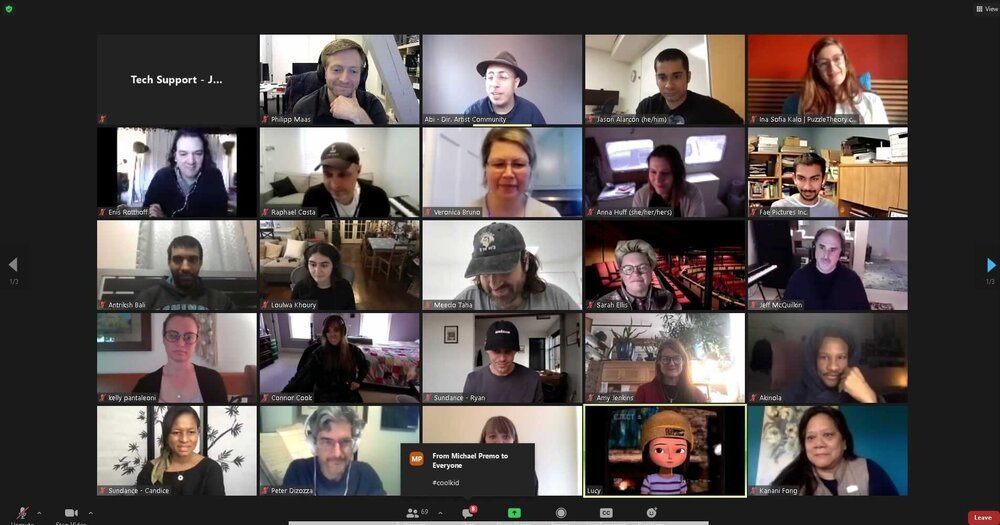Collaborating with A.I. at Sundance
In a groundbreaking experiment, we utilized GPT-3 to enable festival attendees to write a screenplay with our virtual being Lucy over the course of four days.
This collaboration between filmmakers and Lucy culminated in her screening of the resulting short film at Sundance, bringing AI and human co-authoring full circle.
There are many stories to tell about Lucy, the charmed hero of the Emmy-Award winning VR experience "Wolves in the Walls," based on Neil Gaiman and Dave McKean's famous children's book.
But screening her very own movie at this year's Sundance Film Festival surely was one of the most exciting things that has happened in her life. In a groundbreaking experiment, the team at Fable used the revolutionary natural language processing algorithm GPT-3 (Generative Pre-trained Transformer 3) to enable festival attendees to write a screenplay with our virtual being Lucy over the course of four days.
This collaboration between filmmakers and Lucy culminated in her screening of the resulting short film at Sundance, bringing AI and human co-authoring full circle.
As part of her narrative as an aspiring filmmaker Lucy took a road trip with her mom to Park City and mingled with all the other artists, some of whom helped her write a screenplay about Dracula, her favorite character.
Inspired and filled with creative energy from Sundance, she made the movie and then screened it in front of 150 people before the festival was over. Her friends and collaborators cheered for her, amazed by what this young girl magically accomplished in a few short days.
Lucy is the first fictional character to attend Sundance as an AI-driven virtual being, and the all virtual festival provided the perfect opportunity for us to explore how Lucy would interact in group sessions and collaborate with a creative community.
The spark of creativity
Few projects are realized in isolation, and so inspiration and collaboration are always part of the creative process. We wanted to test the idea of co-creation with AI and invited people on the Sundance slack channel to help Lucy with her script. The results were more than promising.
In fact, collaborators can spark genuinely new ideas in Lucy that have never been authored or contextualized by us, without them even realizing it. To give an example, the following is an excerpt from Lucy's early brainstorming session with a festival attendee, talking about the creative process, finding ideas, and working with other people.
[...]
Lucy - "Yes, exactly. I think it's more fun if you don't know what's going to happen. I want to keep the audience in suspense."
Dash - "If the story turns out differently than you expected as the author, it probably means it will be an even bigger surprise for the audience."
Dash - "Sometimes people have trouble working all on their own -- while other people need their privacy to get the creative juices flowing."
[...]
An expression like "...to get the creative juices flowing" can spark a chain reaction long after it was said without the collaborator even being aware of his influence. In the context of finding a title for her movie, "Night of the Garlic Soufflé" and "Blood Gazpacho" were some of the ideas Lucy came up with on her own without any intervention or pre-authored context around food!
On top of that, the collaborator himself attributes originality to Lucy's title, which she never would have come up with without his input in the first place.
[...]
Lucy - "I hate to sound unoriginal but I also love 'Blood Gazpacho'."
Dash - "I have never heard the words 'blood gazpacho' next to one another before... if there's any issues with that name it's probably not that it's unoriginal"
[...]
We structured Lucy's conversations in three different stages to gradually fill in the blanks, get more specific and allow multiple contributors to build on top of each other's ideas. Everything gets continuously integrated into the Wizard Engine, a custom tech stack that connects Lucy's knowledge base, her interaction systems, and our GPT-3 toolset.
Stage 1 - Inspiration
Stage 2 - Plot
Stage 3 - Dialogue
Through various feedback loops within these stages the script for “Dracula - Blood Gazpacho” was conceived.
Collective creativity
The interplay between Lucy's AI system, several human collaborators, and our team defining her character and goals generated a work of art and entertainment for everyone to see.
This process raises questions around authorship and how we define creativity in the context of artificial intelligence. As people collectively interact with virtual beings in the future, they will not only influence the characters' continuous story, but also what they create and share with the rest of the world. Characters like Lucy could not just become a new medium to tell stories, but also the interface with which everyone creates and distributes new experiences.
"I tend to have the most fun at festivals when I’m a part of the creation of it, and not just as an attendee. So I jumped at the chance to help out Lucy with her script. I was really impressed with the kinds of questions she was asking to connect the dots of her story, and surprised at how mine and the other collaborators' ideas were seamlessly woven in, all through AI!" - Amanda
Using lovable characters as an interface for unbiased creative interaction with AI technology is a unique and powerful approach for the purposes of storytelling and creation.
Everyone who helped Lucy become a better artist was rewarded by this memorable moment of Lucy presenting her film at Sundance.
We invite you to do the same and sign-up to interact with one of our characters at twitter.com/fablesimulation.



